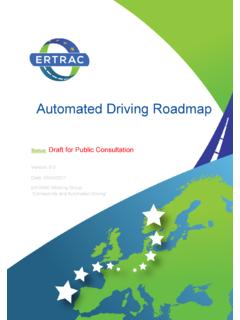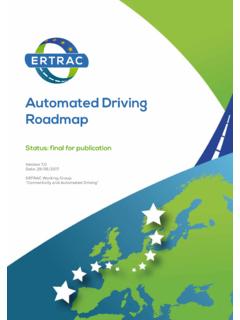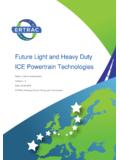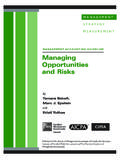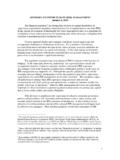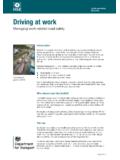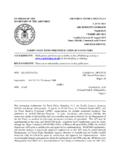Transcription of Automated Driving Roadmap - Ertrac
1 Automated DrivingRoadmapStatus: final for publicationVersion : 29/05/2017 Ertrac Working Group Connectivity and Automated Driving 2 Automated Driving RoadmapAs a European Technology Platform, Ertrac gathers experts from the industry, research providers and public authorities. This Roadmap was prepared by the Working Group Connectivity and Automated Driving , under the leadership of four co-leaders: Armin Graeter (BMW), Mats Rosenquist (Volvo Group), Eckard Steiger (Bosch), and Risto Kulmala (Finnish Transport Agency). The first Automated Driving Roadmap of Ertrac was issued in July 2015 and requested a complete update to cope with the many developments that happened since then.
2 This new 2017 version presents updated definitions and development paths, an updated list of EU and international activities, and an extended list of R&D challenges. The following European projects, funded by Horizon 2020, have provided extensive support for the realisation of this Roadmap :FUTURE-RADAR (coordinated by AVL)SCOUT (coordinated by VDI/VDE-IT)CARTRE (coordinated by ERTICO ITS Europe)ACKNOWLEDGEMENTS:31. Scope and Objectives 42. Common Definitions Levels of Automation Road definitions Current systems Levels 0 and 1 Systems for Automated Passenger Cars Systems for Automated Freight Vehicles Urban Mobility Vehicles 103. Development paths 124.
3 EU and international initiatives European research projects European initiatives EU Member States initiatives Initiatives around the world 285. Key Challenges and Objectives User awareness, users and societal acceptance and ethics, driver training Policy and regulatory needs, European harmonisation 37 Socio-economic assessment and sustainability Safety validation and roadworthiness testing New mobility services, shared economy and business models 38 Big data, artificial intelligence and their applications Digital and physical infrastructure In-vehicle technology enablers Production and industrialisation Human Factors 41 Connectivity 42 6. Recommendations for Horizon 2020 Work Programme 2018-2020 437.
4 Annex Common Definitions: current systems Levels 0 and 1 List of European funded projects addressing Connected and Automated Driving 51 TABLE OF CONTENTS4 Automated Driving RoadmapThe main objective of the Ertrac Roadmap is to provide a joint stakeholders view on the development of Automated Driving in Europe. The Roadmap starts from common definitions and a listing of available technologies, and then identifies the challenges for the implementation of higher levels of Automated Driving functions. Development paths are provided for the different categories of Key Challenges identified should lead to efforts of Research and Development: Ertrac calls for pre-competitive collaboration among European industry and research providers.
5 The key role of public authorities is also highlighted: for policy and regulatory needs, with the objective of European about Connectivity: the scope of this Roadmap is by purpose limited to not cover all aspects of connectivity in Transport. Connectivity will be addressed only when it is used to support the automation of Driving functions: Why Automated Driving ? Automated Driving is seen as one of the key technologies and major technological advancements influencing and shaping our future mobility and quality of life. The main drivers for higher levels of Automated Driving are: Safety: Reduce accidents caused by human errors. Efficiency and environmental objectives: Increase transport system efficiency and reduce time in congested traffic by new urban mobility solutions.
6 Also, smoother traffic will help to decrease the energy consumption and emissions of the vehicles. Comfort: Enable user s freedom for other activities when Automated systems are active. Social inclusion: Ensure mobility for all, including elderly and impaired users. Accessibility: Facilitate access to city Driving must therefore take a key role in the European Transport policy, since it can support several of its objectives and societal challenges, such as road safety, congestion, decarbonisation, social inclusiveness, etc. The overall efficiency of the transport system can be much increased thanks to , Automated Driving should be understood as a process taking place in parallel and possibly in integration with other important evolution of road transport: the electrification of the powertrains, and the multiplication of mobility offers, especially shared mobility concepts.
7 This Roadmap for Automated Driving therefore contributes to the long-term vision of Ertrac for the transport system. In one sentence: in 2050, vehicles should be electrified, Automated and shared..1. SCOPE AND Levels of AutomationERTRAC acknowledges the definitions of SAE J3016 defining the Levels of Automated Driving . Their latest version shall be used, after the revision adopted in September 2016, as accessible on: The figure below is a summary of these definitions and can be used for visual presentations, but experts shall always refer to the full standard 1: SAE Levels of Driving Automation for On-Road Vehicles (September 2016, copyright SAE)Note: the definition of the level 5 of automation is still the object of confusion and different interpretations, in particular in the media and in public institutions.
8 In respect of the SAE definition, the level 5 requires the Automated Driving system to be able to manage all roadway and all environmental conditions. In consequence, any system having limitations of its operational domains cannot pretend being at level 5. The confusion comes often from the use of the full automation wording being associated with the absence of driver in PRT systems: the limited speed and operation in confined area call, however, to classify such systems as Level 4. Ertrac calls for a strict use of the SAE definitions in order to avoid this COMMON DEFINITIONS6 Automated Driving Road definitionsSome roads and areas are more suitable to introduce systems involving high level of automation, before they can be deployed to open roads.
9 Confined areas with restricted access control, such as terminal areas and ports. Dedicated road/lane where vehicles with specific automation level(s) are allowed but the area is not confined, such as parking areas and dedicated lanes. Open road with mixed traffic in single or multiple lane operation on local, regional, and highway operation, for use by vehicles with any automation level. Local, regional, national and European and cross border regulation need to be taken into consideration when targeting automation level. Current systems Levels 0 and 1 Similar than in the 2015 Roadmap . This chapter is available in the Systems for Automated Passenger CarsPassenger cars are the main driver of the development towards Automated Driving , as with their high volume in the market, they can afford to develop the necessary technologies.
10 They evolve level by level with more sensors, connectivity and computing power on- and offboard and can be distinguished by parking and Driving use Automated Parking Parking Assist (Level 2)Partial Automated Parking into and out of a parking space, working on public parking area or in private garage. Via smartphone or key parking process is started, vehicle accomplishes parking manoeuver by itself. The driver can be located outside of the vehicle, but has to constantly monitor the system, and stops the parking manoeuver if Parking Garage Pilot (Level 4)Highly Automated parking including manoeuvring to and from parking place. In parking garage the driver does not have to monitor the system constantly and may leave once the system is active.
